Abstract
Gene therapy used in the context of delivering a therapeutic gene(s) to chondrocytes offers a new approach for treating chondrocyte-mediated cartilage degradation associated with various human arthropathies including osteoarthritis. In this study, gene delivery to human osteoarthritis chondrocytes in monolayer culture was demonstrated using two adenoviral vectors (Ad.CMVlacZ and Ad.RSVntlacZ) carrying the Escherichia coli beta-galactosidase marker gene, and a third vector (Ad.RSV hIL-1ra) containing the cDNA for human interleukin-1 receptor antagonist. At an moi of 10(3) plaque-forming units/chondrocyte, > 90% of the infected cells stained positive for E. coli beta-galactosidase activity, indicating a high efficiency of transduction. Genetically modified chondrocytes were then transplanted onto the articular surface of osteoarthritic cartilage organ cultures with and without the underlying subchondral bone. Both in situ staining of the cartilage organ cultures for E. coli beta-galactosidase activity and examination by scanning electron microscopy indicated that the transplanted chondrocytes adhered and integrated into the articular surface and continued to express transgenic protein. Chondrocytes transduced with Ad.RSV hIL-1ra and seeded onto the surface of osteoarthritic cartilage secreted high levels of biologically active IL-1 receptor antagonist. The Ad.RSV hIL-1ra-treated cartilage samples were resistant to IL1-induced proteoglycan degradation over 10 d of sustained organ culture. These data demonstrate that transplantation of transduced chondrocytes onto the articular surface protects cartilage from IL-1-induced extracellular matrix degradation.
Full text
PDF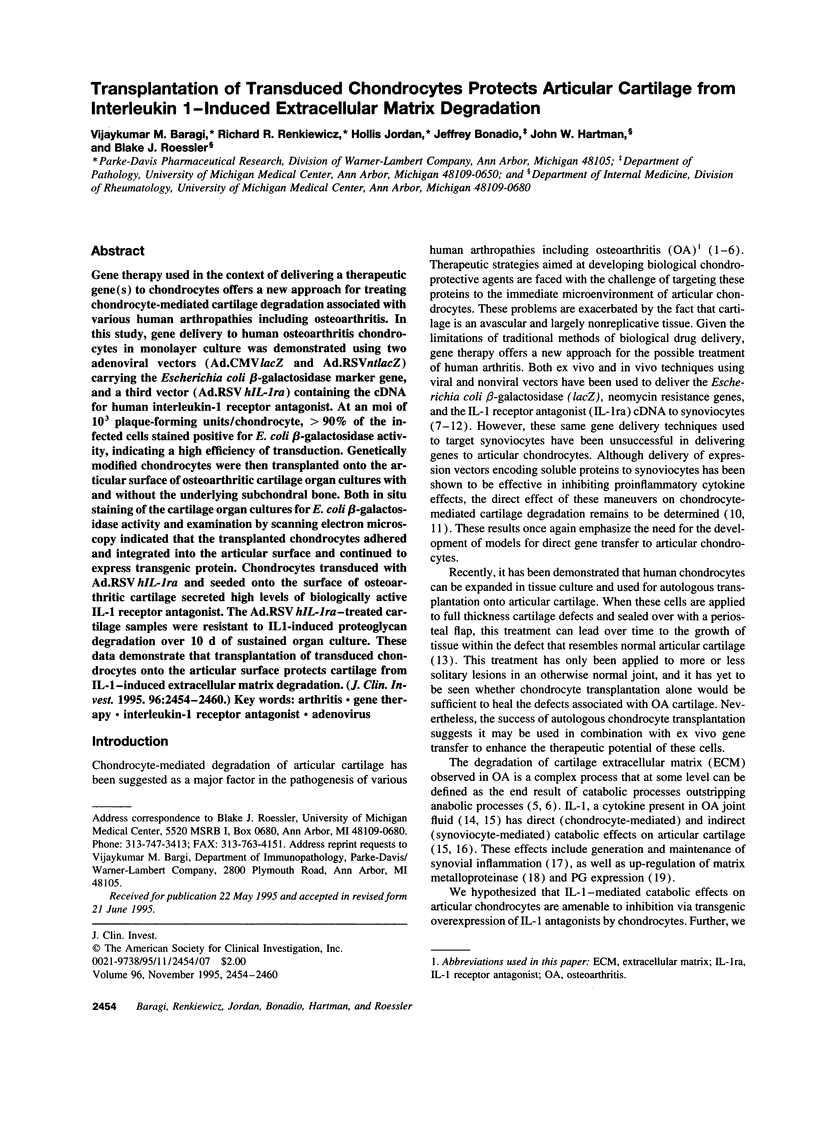
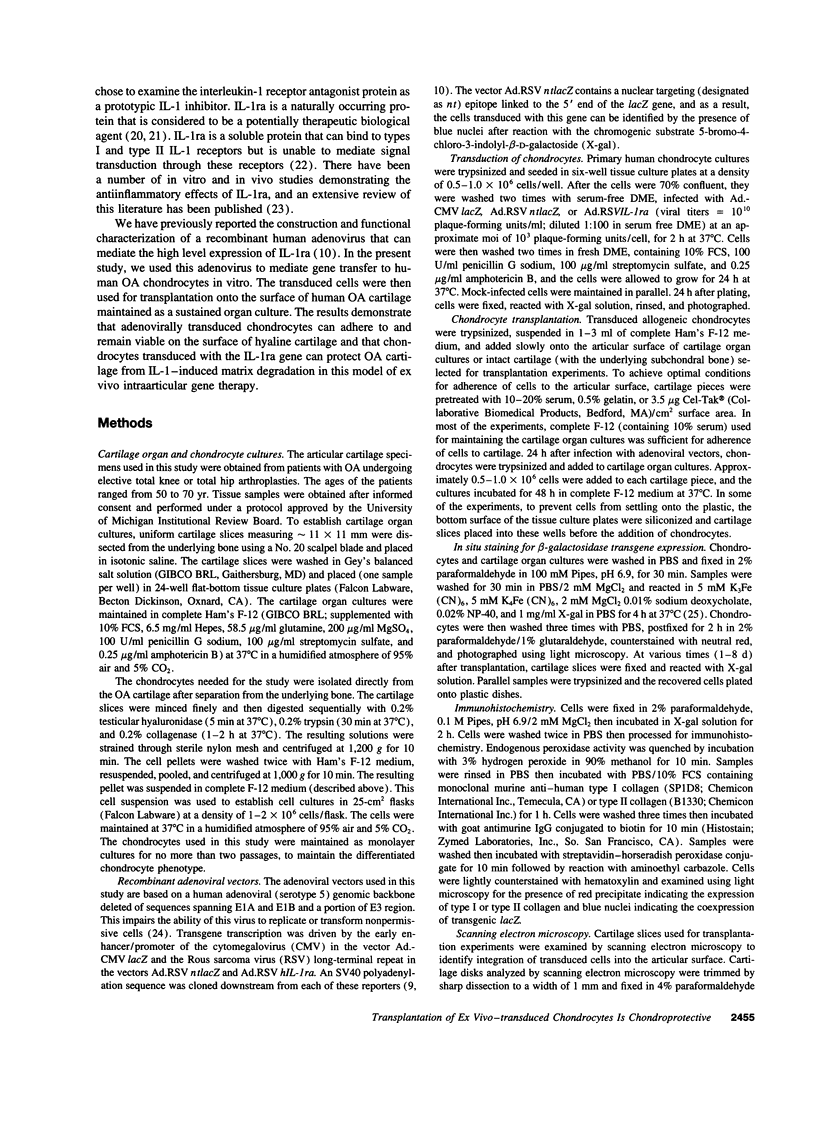
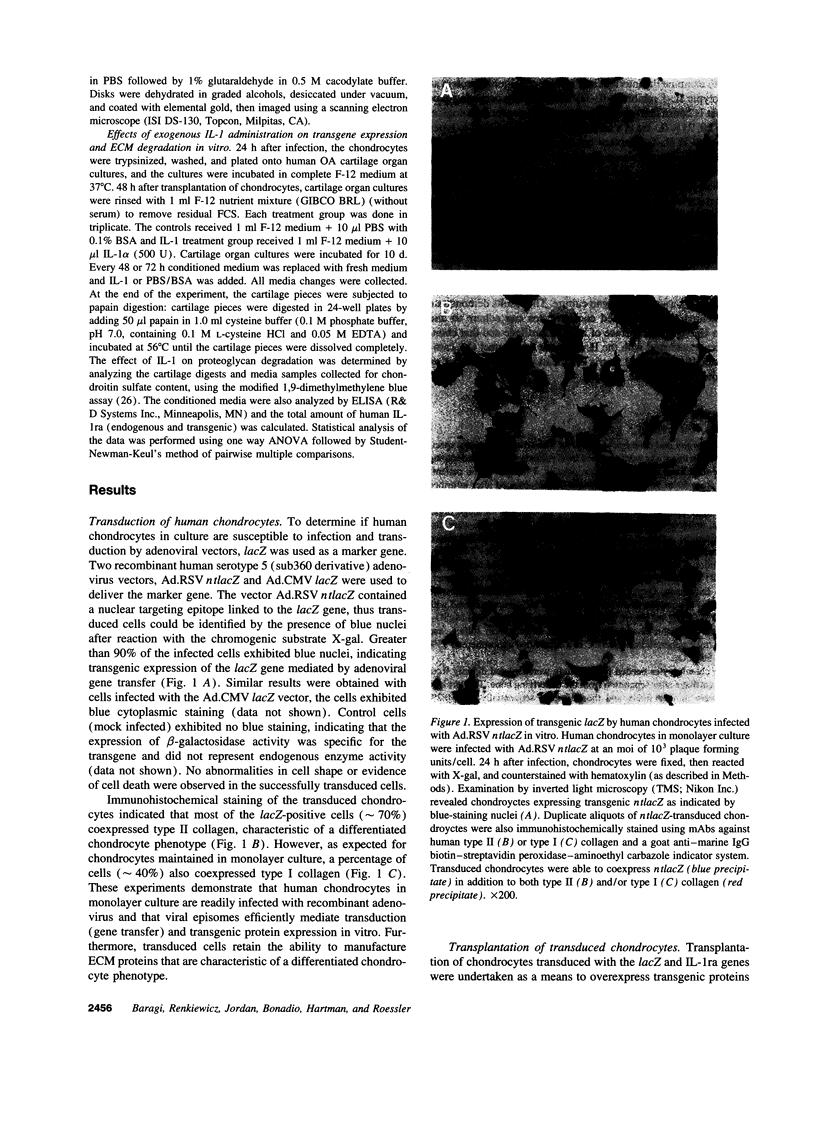
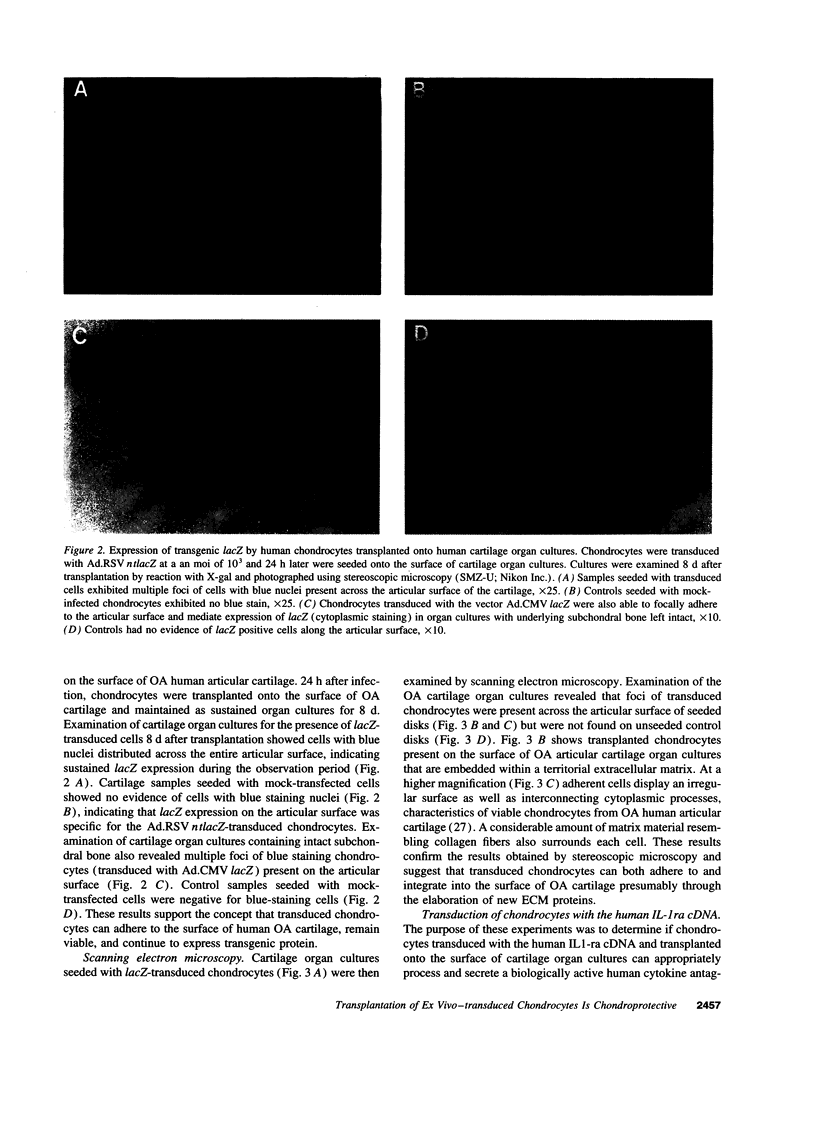
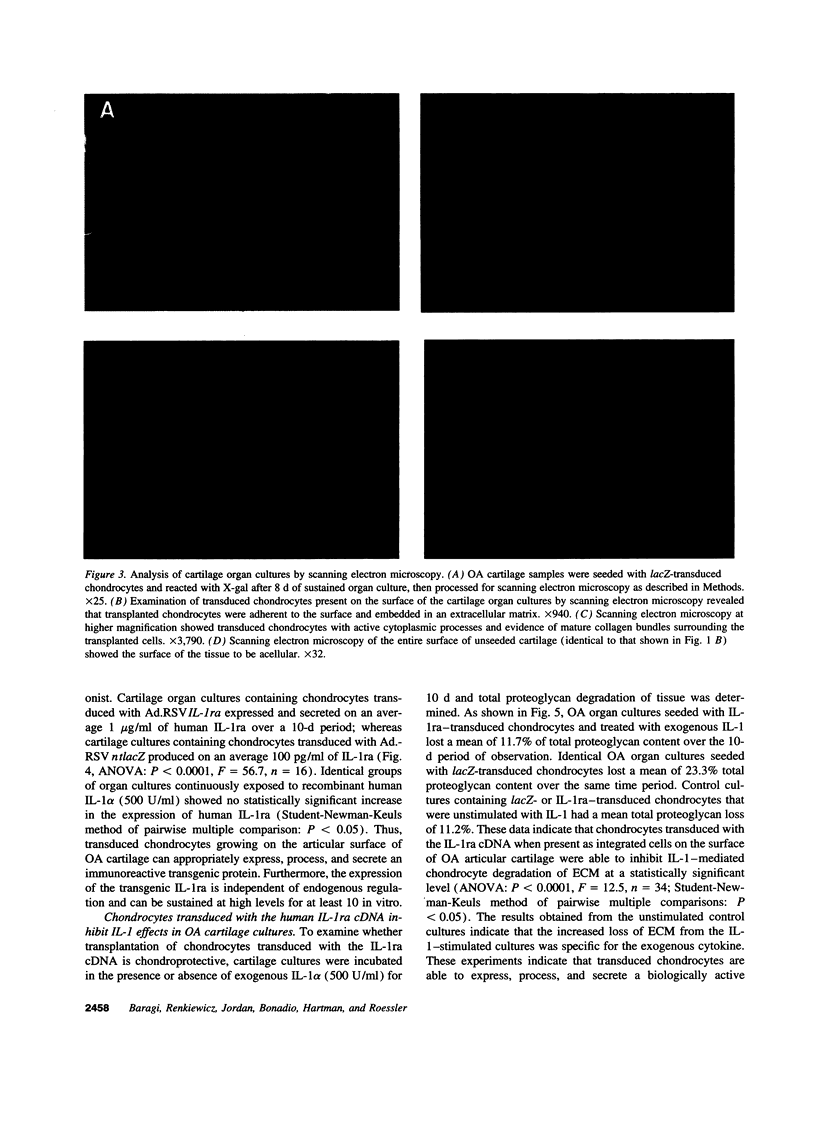
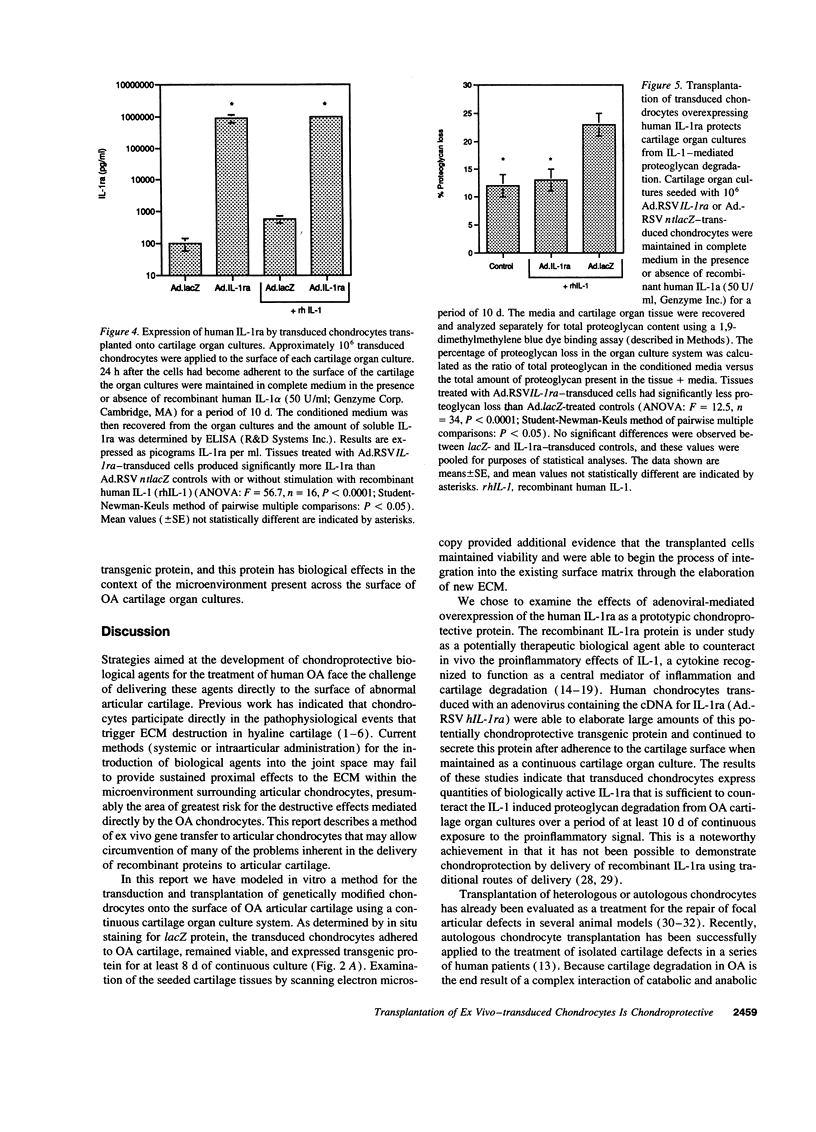
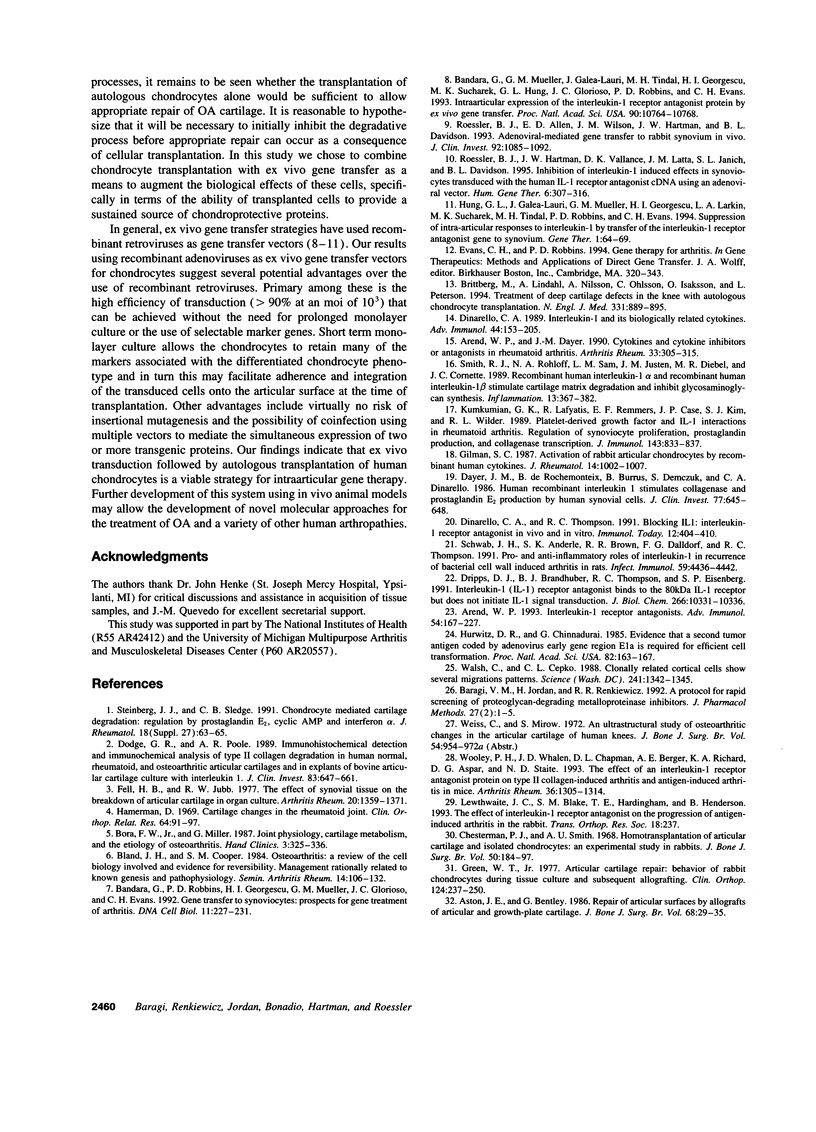
Images in this article
Selected References
These references are in PubMed. This may not be the complete list of references from this article.
- Arend W. P., Dayer J. M. Cytokines and cytokine inhibitors or antagonists in rheumatoid arthritis. Arthritis Rheum. 1990 Mar;33(3):305–315. doi: 10.1002/art.1780330302. [DOI] [PubMed] [Google Scholar]
- Arend W. P. Interleukin-1 receptor antagonist. Adv Immunol. 1993;54:167–227. doi: 10.1016/s0065-2776(08)60535-0. [DOI] [PubMed] [Google Scholar]
- Aston J. E., Bentley G. Repair of articular surfaces by allografts of articular and growth-plate cartilage. J Bone Joint Surg Br. 1986 Jan;68(1):29–35. doi: 10.1302/0301-620X.68B1.3941138. [DOI] [PubMed] [Google Scholar]
- Bandara G., Mueller G. M., Galea-Lauri J., Tindal M. H., Georgescu H. I., Suchanek M. K., Hung G. L., Glorioso J. C., Robbins P. D., Evans C. H. Intraarticular expression of biologically active interleukin 1-receptor-antagonist protein by ex vivo gene transfer. Proc Natl Acad Sci U S A. 1993 Nov 15;90(22):10764–10768. doi: 10.1073/pnas.90.22.10764. [DOI] [PMC free article] [PubMed] [Google Scholar]
- Bandara G., Robbins P. D., Georgescu H. I., Mueller G. M., Glorioso J. C., Evans C. H. Gene transfer to synoviocytes: prospects for gene treatment of arthritis. DNA Cell Biol. 1992 Apr;11(3):227–231. doi: 10.1089/dna.1992.11.227. [DOI] [PubMed] [Google Scholar]
- Bland J. H., Cooper S. M. Osteoarthritis: a review of the cell biology involved and evidence for reversibility. Management rationally related to known genesis and pathophysiology. Semin Arthritis Rheum. 1984 Nov;14(2):106–133. doi: 10.1016/0049-0172(84)90002-7. [DOI] [PubMed] [Google Scholar]
- Bora F. W., Jr, Miller G. Joint physiology, cartilage metabolism, and the etiology of osteoarthritis. Hand Clin. 1987 Aug;3(3):325–336. [PubMed] [Google Scholar]
- Brittberg M., Lindahl A., Nilsson A., Ohlsson C., Isaksson O., Peterson L. Treatment of deep cartilage defects in the knee with autologous chondrocyte transplantation. N Engl J Med. 1994 Oct 6;331(14):889–895. doi: 10.1056/NEJM199410063311401. [DOI] [PubMed] [Google Scholar]
- Chesterman P. J., Smith A. U. Homotransplantation of articular cartilage and isolated chondrocytes. An experimental study in rabbits. J Bone Joint Surg Br. 1968 Feb;50(1):184–197. [PubMed] [Google Scholar]
- Dayer J. M., de Rochemonteix B., Burrus B., Demczuk S., Dinarello C. A. Human recombinant interleukin 1 stimulates collagenase and prostaglandin E2 production by human synovial cells. J Clin Invest. 1986 Feb;77(2):645–648. doi: 10.1172/JCI112350. [DOI] [PMC free article] [PubMed] [Google Scholar]
- Dinarello C. A. Interleukin-1 and its biologically related cytokines. Adv Immunol. 1989;44:153–205. doi: 10.1016/s0065-2776(08)60642-2. [DOI] [PubMed] [Google Scholar]
- Dinarello C. A., Thompson R. C. Blocking IL-1: interleukin 1 receptor antagonist in vivo and in vitro. Immunol Today. 1991 Nov;12(11):404–410. doi: 10.1016/0167-5699(91)90142-G. [DOI] [PubMed] [Google Scholar]
- Dodge G. R., Poole A. R. Immunohistochemical detection and immunochemical analysis of type II collagen degradation in human normal, rheumatoid, and osteoarthritic articular cartilages and in explants of bovine articular cartilage cultured with interleukin 1. J Clin Invest. 1989 Feb;83(2):647–661. doi: 10.1172/JCI113929. [DOI] [PMC free article] [PubMed] [Google Scholar]
- Dripps D. J., Brandhuber B. J., Thompson R. C., Eisenberg S. P. Interleukin-1 (IL-1) receptor antagonist binds to the 80-kDa IL-1 receptor but does not initiate IL-1 signal transduction. J Biol Chem. 1991 Jun 5;266(16):10331–10336. [PubMed] [Google Scholar]
- Fell H. B., Jubb R. W. The effect of synovial tissue on the breakdown of articular cartilage in organ culture. Arthritis Rheum. 1977 Sep-Oct;20(7):1359–1371. doi: 10.1002/art.1780200710. [DOI] [PubMed] [Google Scholar]
- Gilman S. C. Activation of rabbit articular chondrocytes by recombinant human cytokines. J Rheumatol. 1987 Oct;14(5):1002–1007. [PubMed] [Google Scholar]
- Green W. T., Jr Articular cartilage repair. Behavior of rabbit chondrocytes during tissue culture and subsequent allografting. Clin Orthop Relat Res. 1977 May;(124):237–250. [PubMed] [Google Scholar]
- Hamerman D. Cartilage changes in the rheumatoid joint. Clin Orthop Relat Res. 1969 May-Jun;64:91–97. [PubMed] [Google Scholar]
- Hung G. L., Galea-Lauri J., Mueller G. M., Georgescu H. I., Larkin L. A., Suchanek M. K., Tindal M. H., Robbins P. D., Evans C. H. Suppression of intra-articular responses to interleukin-1 by transfer of the interleukin-1 receptor antagonist gene to synovium. Gene Ther. 1994 Jan;1(1):64–69. [PubMed] [Google Scholar]
- Hurwitz D. R., Chinnadurai G. Evidence that a second tumor antigen coded by adenovirus early gene region E1a is required for efficient cell transformation. Proc Natl Acad Sci U S A. 1985 Jan;82(1):163–167. doi: 10.1073/pnas.82.1.163. [DOI] [PMC free article] [PubMed] [Google Scholar]
- Kumkumian G. K., Lafyatis R., Remmers E. F., Case J. P., Kim S. J., Wilder R. L. Platelet-derived growth factor and IL-1 interactions in rheumatoid arthritis. Regulation of synoviocyte proliferation, prostaglandin production, and collagenase transcription. J Immunol. 1989 Aug 1;143(3):833–837. [PubMed] [Google Scholar]
- Roessler B. J., Allen E. D., Wilson J. M., Hartman J. W., Davidson B. L. Adenoviral-mediated gene transfer to rabbit synovium in vivo. J Clin Invest. 1993 Aug;92(2):1085–1092. doi: 10.1172/JCI116614. [DOI] [PMC free article] [PubMed] [Google Scholar]
- Roessler B. J., Hartman J. W., Vallance D. K., Latta J. M., Janich S. L., Davidson B. L. Inhibition of interleukin-1-induced effects in synoviocytes transduced with the human IL-1 receptor antagonist cDNA using an adenoviral vector. Hum Gene Ther. 1995 Mar;6(3):307–316. doi: 10.1089/hum.1995.6.3-307. [DOI] [PubMed] [Google Scholar]
- Schwab J. H., Anderle S. K., Brown R. R., Dalldorf F. G., Thompson R. C. Pro- and anti-inflammatory roles of interleukin-1 in recurrence of bacterial cell wall-induced arthritis in rats. Infect Immun. 1991 Dec;59(12):4436–4442. doi: 10.1128/iai.59.12.4436-4442.1991. [DOI] [PMC free article] [PubMed] [Google Scholar]
- Smith R. J., Rohloff N. A., Sam L. M., Justen J. M., Deibel M. R., Cornette J. C. Recombinant human interleukin-1 alpha and recombinant human interleukin-1 beta stimulate cartilage matrix degradation and inhibit glycosaminoglycan synthesis. Inflammation. 1989 Aug;13(4):367–382. doi: 10.1007/BF00914921. [DOI] [PubMed] [Google Scholar]
- Steinberg J. J., Sledge C. B. Chondrocyte mediated cartilage degradation: regulation by prostaglandin E2, cyclic AMP and interferon alpha. J Rheumatol Suppl. 1991 Feb;27:63–65. [PubMed] [Google Scholar]
- Walsh C., Cepko C. L. Clonally related cortical cells show several migration patterns. Science. 1988 Sep 9;241(4871):1342–1345. doi: 10.1126/science.3137660. [DOI] [PubMed] [Google Scholar]
- Weiss C., Mirow S. An ultrastructural study of osteoarthritis changes in the articular cartilage of human knees. J Bone Joint Surg Am. 1972 Jul;54(5):954–972. [PubMed] [Google Scholar]
- Wooley P. H., Whalen J. D., Chapman D. L., Berger A. E., Richard K. A., Aspar D. G., Staite N. D. The effect of an interleukin-1 receptor antagonist protein on type II collagen-induced arthritis and antigen-induced arthritis in mice. Arthritis Rheum. 1993 Sep;36(9):1305–1314. doi: 10.1002/art.1780360915. [DOI] [PubMed] [Google Scholar]













